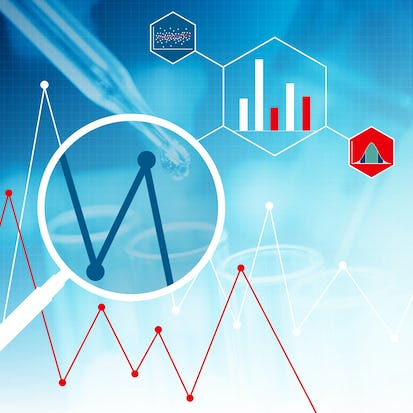- Level Foundation
- Duration 15 hours
- Course by University of Cape Town
-
Offered by

About
This course aims to empower you to do statistical tests, ready for incorporation into your dissertations, research papers, and presentations. The ability to summarize data, create plots and charts, and to do the statistical tests that you commonly see in the literature is a powerful skill indeed. There are powerful tools readily available to achieve these goals. None are quite as easy to learn, yet as powerful to use, as the Wolfram Language. Knowledge is literally built into the language. With its well-structured and consistent approach to creating code, you will become an expert in no time. This course follows the approach of learning statistical analysis through the use of a computer language. It requires no prior knowledge of coding. An exciting journey awaits. If you want even more, there are optional Honors lessons on machine learning that cover the support in the Wolfram Language for deep learning.Modules
1. Introduction
1
Discussions
- Introduce Yourself
6
Videos
- Welcome
- The Klopper Research Group
- Assumptions
- Learning a computer language
- Why the Wolfram language?
- Getting Mathematica
4
Readings
- How this Course Works
- Welcome to Module 1
- Meet the Course Instructor
- Module 1 Notebook
2. The Wolfram Cloud
4
Videos
- The new Wolfram Cloud
- The Wolfram Cloud
- The Wolfram Programming Lab
- Free-form input and Wolfram Alpha in the Cloud
1
Readings
- Welcome to Wolfram Cloud
3. Mathematica
1
Discussions
- Optional Assignment - share your first Wolfram Notebook
4
Videos
- Mathematica
- Free-form input and Wolfram Alpha in the desktop
- Help and documentation
- Assignment notebooks
3
Readings
- Welcome to Module 3
- Module 3 Notebook
- Module 3 Exercise
4. Simulated data demonstration
3
Videos
- Create Your Own Computational Essay
- Simulated data demonstration - part 1
- Simulated data demonstration - part 2
2
Readings
- Welcome to Module 4
- Module 4 Notebook
5. Simple arithmetic
6
Videos
- Simple arithmetic
- Addition and subtraction
- Multiplication and division
- Powers
- Arithmetical order
- Calculating a mean
2
Readings
- Welcome to Module 5
- Module 5 Exercise
Quiz 1
1
Assignment
- Modules 1 to 5
6. Working with data
11
Videos
- Working with data
- Lists part 1
- Lists part 2
- Tables
- Index
- Datasets
- Selecting
- Dataset functions
- Creating lists from datasets
- Spreadsheets
- Spreadsheets in the cloud
3
Readings
- Welcome to Module 6
- Module 6 Notebook
- Module 6 Exercise
Optional: Working with the Wolfram Data Repository
1
Readings
- Coronavirus data analysis
Week 3 - Summary Statistics
1
Videos
- Summary Statistics
7. Descriptive Statistics
5
Videos
- Descriptive statistics
- Data import for descriptive statistics
- Creating lists for descriptive statistics
- Point estimates
- Measures of dispersion
3
Readings
- Welcome to Module 7
- Module 7 Notebook
- Module 7 Exercise
8. Data Visualization
6
Videos
- Data Visualization
- Data import for visualization
- Scatter plots
- Box plots
- Histograms
- Bar and pie charts
3
Readings
- Welcome to Module 8
- Module 8 Notebook
- Module 8 Exercise
9. Distributions
7
Videos
- Distributions
- Probability
- PDF and CDF
- Discrete distributions
- Continuous distributions
- Sampling distributions
- Simulated data
3
Readings
- Welcome to Module 9
- Module 9 Notebook
- Module 9 Exercise
Quiz 2
1
Assignment
- Modules 6 to 9
Honors - Neural network basics
1
Assignment
- Honors: Deep learning basics
8
Videos
- 01: Introduction to neural networks
- 02: Introduction to machine learning
- 03: The fundamentals
- 04: Basic framework of a neural network
- 05: Layers in a neural network
- 06: Reviewing a neural network
- 07: From inputs to predictions
- 08: Finding a solution
1
Readings
- Neural networks in the Wolfram language
Week 4: Inferential Statistics
1
Videos
- Inferential Statistics
10. Linear regression
4
Videos
- Linear regression
- Importing data
- Descriptive statistics and visualization
- Linear model
3
Readings
- Welcome to Module 10
- Module 10 Notebook
- Module 10 Exercise
11. Comparing means
4
Videos
- Comparing means
- Data import
- Comparing two means
- Comparing more than two means
3
Readings
- Welcome to Module 11
- Module 11 Notebook
- Module 11 Exercise
12. Comparing categorical variables
3
Videos
- Comparing categorical variables
- Contingency tables
- Chi-squared test
3
Readings
- Welcome to Module 12
- Module 12 Notebook
- Module 12 Exercise
13. Creating a computational essay
1
Discussions
- Submit Your Computational Essay
4
Videos
- Creating a Computational Essay
- Data import
- Main research question
- Secondary research questions
2
Readings
- Welcome to Module 13
- Module 13 Notebook
Quiz 3
1
Assignment
- Modules 10 to 13
Final Exam
1
Assignment
- Final Exam
1
Videos
- Congratulations on reaching the end
1
Readings
- Final Exam Instructions
Honors - Machine Learning
1
Assignment
- Honors: Deep learning functions
10
Videos
- 09: Introduction to Wolfram Language machine learning
- 10: Automated Machine Learning
- 11: Running an automated algorithm
- 12: Testing the automated algorithm
- 13: Setting the method to neural network
- 14: Normalizing the data
- 15: Manually created neural networks
- 16: Regression - part 1
- 17: Regression - part 2
- 18: Regression - part 3
1
Readings
- Continuing your journey with deep neural networks
Auto Summary
"Doing Clinical Research: Biostatistics with the Wolfram Language" is a foundational course designed to equip you with the skills to conduct statistical tests essential for dissertations, research papers, and presentations. This course falls under the Big Data and Analytics domain and is offered by Coursera. Under the expert guidance of the instructor, you will learn to summarize data, create plots and charts, and perform common statistical tests using the Wolfram Language. Known for its ease of learning and powerful capabilities, the Wolfram Language integrates knowledge directly into its syntax, offering a structured and consistent approach to coding that even beginners can master quickly. The course takes a unique approach by teaching statistical analysis through practical coding exercises, with no prior coding experience required. For those looking for an advanced challenge, optional Honors lessons delve into machine learning and deep learning using the Wolfram Language. Spanning approximately 900 minutes of content, the course is available through two subscription options: Starter and Professional. Ideal for aspiring researchers, data analysts, and students in clinical research, this course promises a comprehensive introduction to biostatistics and the powerful tools available in the Wolfram Language. Embark on this exciting journey to enhance your analytical skills and advance your research capabilities.

Juan H Klopper

